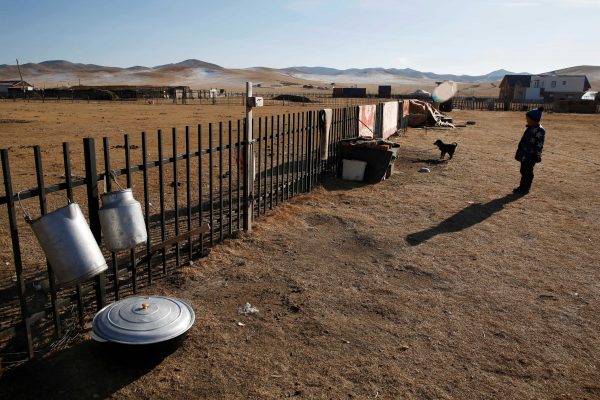Until November, Mongolia was a rare COVID-19 success story. Recognising the limits of its public health system, the government reacted quickly to news of the COVID-19 outbreak in January Tsagaan Sar (lunar new year) was reimagined to curtail family visits and the same is envisioned for the coming festivities in 2021. The government built on lessons from a 2019 World Health Organization-supported ‘Pandemic Flu Readiness’ workshop. Mongolia’s relative isolation enabled the government to react quickly and tightly control its borders, preventing community infections for much of 2020. As is the case for many countries, the question of procurement of vaccines is on the horizon and somewhat unresolved.
But on 11 November, Mongolia saw its first case of community infection. A strict lockdown was enacted the next day. While this lockdown seemed to have effectively curtailed infections, a new cluster appeared in Ulaanbaatar around Christmas and the government is still struggling to contain it with rigid lockdowns.
The economic impact of COVID-19 in Mongolia has been mitigated by preventing community transmission. Still, self-employed and herder households have suffered losses. The economy has been hit hard by limits imposed on mineral exports, especially after the closure of the China–Mongolia border which blocked truck-based coal exports. Mining sites have now reopened and are operating somewhat normally. Tourism has been decimated. The largest copper mining operations, Erdenet and Oyu Tolgoi, hire significant numbers of expatriate employees and have been impacted by travel restrictions. Mongolian GDP shrunk by nearly 10 per cent in 2020, but the Asian Development Bank projects a 5.1 per cent recovery in 2021.
Somewhat surprisingly, Mongolia joined the Asia Pacific Trade Agreement (APTA) in late September. While the immediate impact on trade with APTA members like Sri Lanka and Bangladesh may be limited, and trade with larger economies like China and South Korea is unlikely to change, this membership represents another step in Mongolia’s regional trade diplomacy. It signals to domestic industries that international trade relations are improving, bringing further standardisation and other benefits.
One foreign policy development with significant long-term implications was the confrontation over new language policies in China’s Inner Mongolian Autonomous Region (IMAR) in September. Some Mongolian and international advocates refer to the IMAR as ‘Southern Mongolia’ and this perspective gained traction in Mongolia over the summer. Protests against the policies in Southern Mongolia built over the summer.
The most prominent Mongolian to join the online protests was former president Tsakhiagiin Elbegdorj. This was noticed by Beijing in preparation for a visit by Chinese Foreign Minister Wang Yi in September. This may represent a shift towards a harder attitude to Mongolia in line with more aggressive stances elsewhere in the region. Perhaps in an effort to please the visiting boss, Chinese Ambassador Chai Wenrui called out Elbegdorj as a hypocrite.
Given there have been no further tensions in China–Mongolia relations, this may have been a blip of negativity. But with more reactions to Chinese assertiveness likely to come from Australia, Europe and the United States, Mongolia will be forced to walk a fine line between objecting to Chinese aggression and authoritarianism while maintaining constructive, economically vital relationships.
The biggest event in domestic politics was the parliamentary election on 24 June. With a campaign that was mildly constrained by COVID-19 distancing measures, Mongolians voted in strong numbers and gave a landslide victory to the Mongolian People’s Party (MPP). This was the first time in 30 years of multiparty democracy that a sitting government was re-elected with a majority.
The MPP now holds 62 of the 76 seats, but nearly half of those parliamentarians are newly elected, largely due to Prime Minister and party leader Ukhnaagiin Khurelsukh’s efforts to rejuvenate the party. The MPP’s success can be attributed to its efforts on curbing air pollution in Ulaanbaatar in 2019–20, and its competent response to COVID-19.
Following constitutional amendments passed in 2019, Khurelsukh’s cabinet now only includes four sitting MPs, with the majority of ministers bringing professional expertise to portfolios. It remains to be seen whether this signals a shift of power and interaction between cabinet and parliament, and whether new MPs will develop a coherent policy and legislative agenda.
Despite the MPP’s supermajority, further legislation to specify aspirations of the 2019 constitutional amendments has not been passed. This is particularly glaring when it comes to appointments to and dismissals of judges and prosecutors to bolster judicial independence. 2020 has seen a spate of prosecutions of former politicians that seem politically motivated in terms of timing.
In June 2021, Mongolians will elect a president to a single six-year term as per the 2019 constitutional amendments. President Khaltmaagiin Battulga is expected to be ‘grandfathered’ out of the single-term provision and will seek the nomination of the Democratic Party. Most observers expect Prime Minister Khurelsukh to be nominated by the MPP, riding his wave of COVID-19 success and election popularity. With two additional parties in parliament, it remains unclear what the race will look like. Given the constraints on presidential power, the race to succeed Khurelsukh as prime minister and party chair may turn out to be more significant in policy terms.
Julian Dierkes is Associate Professor at the University of British Columbia’s School of Public Policy and Global Affairs. He is one of the principal authors of the Mongolia Focus blog.
This article is part of an EAF special feature series on 2020 in review and the year ahead.

